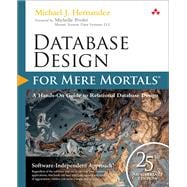- Understand database types, models, and design terminology
- Perform interviews to efficiently capture requirements—even if everyone works remotely
- Set clear design objectives and transform them into effective designs
- Analyze a current database so you can identify ways to improve it
- Establish table structures and relationships, assign primary keys, set field specifications, and set up views
- Ensure the correct level of data integrity for each database
- Identify and establish business rules
- Preview and prepare for the future of relational databases










